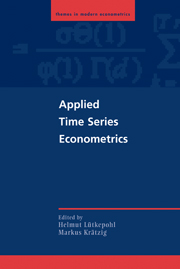Book contents
- Frontmatter
- Contents
- Preface
- Notation and Abbreviations
- List of Contributors
- 1 Initial Tasks and Overview
- 2 Univariate Time Series Analysis
- 3 Vector Autoregressive and Vector Error Correction Models
- 4 Structural Vector Autoregressive Modeling and Impulse Responses
- 5 Conditional Heteroskedasticity
- 6 Smooth Transition Regression Modeling
- 7 Nonparametric Time Series Modeling
- 8 The Software JMu⌉Ti
- References
- Index
5 - Conditional Heteroskedasticity
Published online by Cambridge University Press: 23 November 2009
- Frontmatter
- Contents
- Preface
- Notation and Abbreviations
- List of Contributors
- 1 Initial Tasks and Overview
- 2 Univariate Time Series Analysis
- 3 Vector Autoregressive and Vector Error Correction Models
- 4 Structural Vector Autoregressive Modeling and Impulse Responses
- 5 Conditional Heteroskedasticity
- 6 Smooth Transition Regression Modeling
- 7 Nonparametric Time Series Modeling
- 8 The Software JMu⌉Ti
- References
- Index
Summary
Stylized Facts of Empirical Price Processes
Price processes observed at speculative markets such as foreign exchanges or stock, bond, or commodity markets have been attracting a huge interest in the academic world for decades. A particular time series model that has been proven to approximate empirical (log) price processes quite accurately is the random walk model [Fama (1965)]. According to this model the best forecast of a future price is today's price and, thus, the latter summarizes efficiently the (publicly) available information for prediction. Although the concept of weak market efficiency may also cover some degree of predictability of future price changes [Campbell, Lo & MacKinlay (1997)], there is a wide consensus that (log) speculative prices are nonstationary and, more precisely, show dynamic properties in line with processes that are integrated of order one.
Given nonstationarity of actual price processes, the statistical analysis mostly concentrates on speculative returns. Changes of log speculative prices (compounded returns) are typically not, or at most weakly, autocorrelated [Campbell et al. (1997)]. Measured at some higher frequency, daily price variations, for example, exhibit positive autocorrelation. Periods of higher and smaller price variations alternate; empirical volatilities tend to cluster. The latter property is easily found in the empirical autocorrelation function of squared returns. Thus, although price processes are hardly predictable, the variance of the forecast error is time dependent and can be estimated by means of observed past variations. As a consequence of volatility clustering, it turns out that the unconditional distribution of empirical returns is at odds with the hypothesis of normally distributed price changes that had been put forth by Bachelier (1900) and was powerfully rejected by Fama (1965).
Information
- Type
- Chapter
- Information
- Applied Time Series Econometrics , pp. 197 - 221Publisher: Cambridge University PressPrint publication year: 2004
Accessibility standard: Unknown
Why this information is here
This section outlines the accessibility features of this content - including support for screen readers, full keyboard navigation and high-contrast display options. This may not be relevant for you.Accessibility Information
- 7
- Cited by
